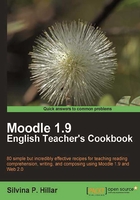
What this book covers
Chapter 1, Connecting Ideas covers how to design several types of exercises so that students can enrich the use of connectors. Guided writing activities are also carried out such as answering a quiz, connecting stairs, writing a story out of pictures and completing a chart.
Chapter 2, Matching Pictures and Text covers how to work with reading comprehension, not only in the classical way, but also adding pictures so as to explore another side to it. After matching activities the writing part is a must.
Chapter 3, Looking at Things from Different Perspectives covers how to develop an interest in reading for our students. After reading comprehension activities, students are to write several pieces considering the fact that they are inside what they have already read.
Chapter 4, Defining Types of Sentences covers how to insert several types of activities concerning three types of sentences within a paragraph. The last recipe includes a structure on how to write a composition using the three types of sentences so as to do a coherent piece of writing.
Chapter 5, Creating Stories Using Twitter and Facebook covers how to embed both social networks in our Moodle course, and develop writing activities exploiting the resources of both of them. Apart from that we will use management technique and upload it into the social network.
Chapter 6, Improving Your Students' Writing covers cubing technique, showing how it works, exploring each side of the cube through interesting activities, after using all the sides of the cube in one recipe.
Chapter 7, Comparing Using Venn Diagram covers how to organize writing using Venn diagrams, which are drawn using different software, commercial and open source, and resources from the Web 2.0.
Chapter 8, Composing New Sceneries covers a wide range of colorful and interesting activities presenting students with well known items which they have to change or twist so as to create something different. Several resources from the Web 2.0 can be inserted in the Moodle course.
Chapter 9, Working with Mind Maps and Tree Diagrams covers how to design Mind Maps and Tree diagrams in different ways and upload or link them into our Moodle course. After that students create different pieces of writing.
Chapter 10, Preparing a Discussion Clock covers how to examine various viewpoints (12) after a given topic. Designing and uploading of different discussion clocks is covered in this chapter.